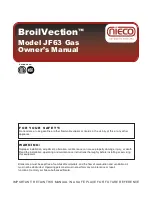
16
INTRODUCTION
Priority setting
Parameter 42 sets the priorities between the DHW and CH circuit.
Four modes are available:
0
Time
: timed priority between the two circuits. In the event of a
simultaneous demand, initially the domestic hot water circuit
is made to operate for a number of minutes equal to the value
assigned on parameter 43. At the end of this time period, the
CH circuit is operated (also for the same amount of time) and
so on until demand for one or the other circuit is satisfied
1
Off
: priority is to the heating circuit
2
On
: priority is to the DHW circuit
3
Parallel
: simultaneous operation of both circuits provided that
the delivery temperature requested by the DHW circuit is lower
than or equal to the setpoint requested by the heating circuit.
When the temperature requested by the DHW circuit exceeds
the heating setpoint, the circulation pump of the heating is
turned off and priority is switched to the DHW.
Anti-Legionella function
When the production of domestic hot water is activated (Par. 35=
1), using parameters 107 and 108 it is possible to carry out weekly
scheduling of the “Anti-legionella” function.
Parameter 107 sets the day of the week in which the activity is per-
formed, while parameter 108 sets the time.
At the planned time, the boiler generates a call for the DHW indirect
storage tank with a pre-set set-point of 140 °F (60 °C) (not adjust-
able). After reaching 140 °F (60 °C), the temperature is maintained
for 30 minutes, during which the system checks that the sensor's
temperature does not fall below 134.6 °F (57 °C). At the end of this
time interval, the Anti-Legionella function stops and standard op-
eration of the boiler is resumed.
Operation in “Anti-Legionella” mode has priority over other de-
mands independently from the setting of the parameter 42.
Par.
No. Description
107
Sets the weekday on which the anti-Legionella procedure
is carried out.
108 Sets the time of the day during which the anti-Legionella
procedure is carried out.
4.11.1
Scheduled program
The scheduled program is designed to program the operation of
the various circuits managed by the boiler, (CH, DHW and additional
mixed zones).
Seasonal Program
The seasonal program is used to exclude additional mixed zones
during the summer season.
It does not control any DHW parameter.
4.12
General Safety Information
9
WARNING:
Water temperatures over 125°F (52°C) can cause in-
stant severe burns or death from scalds.
When supplying general purpose hot water, the recommended ini-
tial setting for the temperature control is 120°F (49°C).
Safety and energy conservation are factors to be considered when
setting the water temperature on the thermostat.
The most energy-efficient operation will result when the tempera-
ture setting is the lowest that satisfies the needs of the application.
Children, disabled and elderly are at highest risk of being scalded.
− Feel water before bathing or showering.
− Temperature limiting valves are available.
9
NOTE:
(for heating only model): When this boiler is supplying
general purpose hot water for use by individuals, a thermo-
statically controlled mixing valve for reducing point of use water
temperature is recommended to reduce the risk of scald injury.
Contact a qualified plumber or the local plumbing authority for
further information.
Maximum water temperatures occur just after the boiler’s burner
has shut off. To determine the water temperature being delivered,
turn on a hot water faucet and place a thermometer in the hot
water stream and read the thermometer.
4.13
Scalding time/temperature relationships
The following chart details the relationship of water temperature
and time with regard to scald injury and may be used as a guide
in determining the safest water temperature for your applications.
Water Temperature
Time to Produce Serious Burn
120°F (49°C)
More than 5 minutes
125°F (52°C)
1-1/2 to 2 minutes
130°F (54°C)
About 30 seconds
135°F (57°C)
About 10 seconds
140°F (60°C)
Less than 5 seconds
145°F (63°C)
Less than 3 seconds
150°F (66°C)
About 1-1/2 seconds
155°F (68°C)
About 1 second
Table courtesy of The Shriners Burn Institute
The temperature of the water in the boiler can be regulated by us-
ing the
R
boiler front control. To comply with safety regulations,
the control is set to a lower temperature when shipped from the
factory.
9
CAUTION:
Hotter water increases the risk of scalding! There is a
hot water scald potential if the thermostat is set too high.
















































